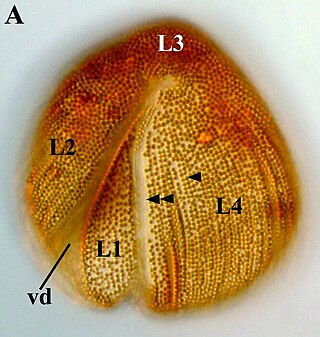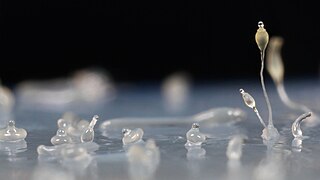Related Research Articles

The Percolozoa are a group of colourless, non-photosynthetic Excavata, including many that can transform between amoeboid, flagellate, and cyst stages.
The parabasalids are a group of flagellated protists within the supergroup Excavata. Most of these eukaryotic organisms form a symbiotic relationship in animals. These include a variety of forms found in the intestines of termites and cockroaches, many of which have symbiotic bacteria that help them digest cellulose in woody plants. Other species within this supergroup are known parasites, and include human pathogens.

Auranticordis is a genus of rare tetraflagellate eukaryotic organisms within the phylum Cercozoa. Currently there is only one characterized species within this genus: Auranticordis quadriverberis.Auranticordis cells are heart shaped and can range from 35 - 75 μm long and 25 - 70 μm wide. These cells move in a forward gliding motion, and are predators in interstitial marine sand habitats. Auranticordis cells contain several features that are unique and dissimilar from other cercozoans, such as black bodies, reduced acristate mitochondria, putative primary endosymbionts, many orange pigmented extrusomes and the absence of permanently condensed chromosomes.
Carpediemonas is genus of Metamonada, and belongs to the group Excavata. This organism is a unicellular flagellated eukaryote that was first discovered in substrate samples from the Great Barrier Reef. Carpediemonas can be found in anaerobic intertidal sediment, where it feeds on bacteria. A feature of this species is the presence of a feeding groove, a characteristic of the excavates. Like most other metamonads, Carpediemonas does not rely on an aerobic mitochondrion to produce energy. Instead, it contains hydrogenosomes that are used to produce ATP. This organism has two flagella: a posterior one used for feeding on the substrate, and an anterior one that moves in a slower sweeping motion. Carpediemonas is assigned to the fornicates, where similar Carpediemonas-like organisms are used in researching the evolution within excavates. Although Carpediemonas is a member of the metamonads, it is unusual in the sense that it is free-living and has three basal bodies.
Trimastix is a genus of excavate protists, the sole occupant of the order Trimastigida. Trimastix are bacterivorous, free living and anaerobic. It was first observed in 1881 by William Kent. There are few known species, and the genus's role in the ecosystem is largely unknown. However, it is known that they generally live in marine environments within the tissues of decaying organisms to maintain an anoxic environment. Much interest in this group is related to its close association with other members of Preaxostyla. These organisms do not have classical mitochondria, and as such, much of the research involving these microbes is aimed at investigating the evolution of mitochondria.

Conosa is a grouping of Amoebozoa. It is subdivided into three groups: Archamoeba, Variosea and Mycetozoa.

Proteromonas is a genus of single-celled biflagellated microbial eukaryotes belonging to the Superphylum Stramenopiles which are characterized by the presence of tripartite, hair-like structures on the anteriorly-directed larger of the two flagella. Proteromonas on the other hand are notable by having tripartite hairs called somatonemes not on the flagella but on the posterior of the cell. Proteromonas are closely related to Karotomorpha and Blastocystis, which belong to the Opalines group.

Mastigamoeba is a genus of pelobionts, and treated by some as members of the Archamoebae group of protists. Mastigamoeba are characterized as anaerobic, amitochondriate organisms that are polymorphic. Their dominant life cycle stage is as an amoeboid flagellate. Species are typically free living, though endobiotic species have been described.

Katabia is a genus of soil-dwelling heterotrophic flagellate cercozoans containing the single species Katabia gromovi, and the only member of family Katabiidae.
Psalteriomonas lanterna is a species of amoebae in the group of Heterolobosea. The cells of the flagellate stage show four nuclei, four ventral grooves and four mastigont systems, each with four flagella. It lacks a Golgi apparatus and reproduction occurs in both stages of its life cycle.
Cochlosoma is a genus of flagellated protozoa in the order Trichomonadida created by A. Kotlán (1923). Some of their typical features include a prominent adhesive disc, axostyle, costa, and six flagella – one of which is attached to an undulating membrane that runs laterally along the body.
Rhodelphis is a single-celled archaeplastid that lives in aquatic environments and is the sister group to red algae and possibly Picozoa. While red algae have no flagellated stages and are generally photoautotrophic, Rhodelphis is a flagellated predator containing a non-photosynthetic plastid. This group is important to the understanding of plastid evolution because they provide insight into the morphology and biochemistry of early archaeplastids. Rhodelphis contains a remnant plastid that is not capable of photosynthesis, but may play a role in biochemical pathways in the cell like heme synthesis and iron-sulfur clustering. The plastid does not have a genome, but genes are targeted to it from the nucleus. Rhodelphis is ovoid with a tapered anterior end bearing two perpendicularly-oriented flagella.
Stygiella /ˌstɪ.d͡ʒiˈɛ.lə/ is a genus of free-living marine flagellates belonging to the family Stygiellidae in the jakobids (excavata).
Holomastigotoides is a genus of parabasalids found in the hindgut of lower termites. It is characterized by its dense, organized arrangement of flagella on the cell surface and the presence of a mitotic spindle outside its nucleus during the majority of its cell cycle. As a symbiont of termites, Holomastigotoides is able to ingest wood and aid its host in digestion. In return, Holomastigotoides is supplied with a stable habitat and steady supply of food. Holomastigotoides has notably been studied to observe the mechanisms of chromosomal pairing and segregation in haploid and diploid cells.
Monocercomonas is a Parabasalian genus belonging to the order Trichomonadida. It presents four flagella, three forward-facing and one trailing, without the presence of a costa or any kind of undulating membrane. Monocercomonas is found in animal guts. and is susceptible to cause Monocercomoniasis in reptiles
Mesofila is a genus of freshwater heterotrophic protists of the phylum Cercozoa. It is the only genus in the family Mesofilidae. It is a monotypic genus, with the sole species M. limnetica.

The glissomonads are a group of bacterivorous gliding flagellated protists that compose the order Glissomonadida, in the amoeboflagellate phylum Cercozoa. They comprise a vast, largely undescribed diversity of soil and freshwater organisms. They are the sister group to cercomonads; the two orders form a solid clade of gliding soil-dwelling flagellates called Pediglissa.

Viridiraptoridae, previously known as clade X, is a clade of heterotrophic protists in the phylum Cercozoa. They're a family of glissomonads, a group containing a vast, mostly undescribed diversity of soil and freshwater organisms.
Bihospites is a genus of symbiontid euglenozoans characterized by the presence of two species of epibiotic bacteria on the cell surface. Bihospites cells are clear, biflagellated, and uninucleated, that range between 40–120 μm long and 15–30 μm wide. Bihospites, as well as other members of the symbiontids, are found in semi-anoxic to anoxic sediments in benthic marine environments. Each cell surface is covered by both rod-shaped and spherical-shaped epibiotic bacteria that may share a commensalistic or mutualistic relationship with Bihospites host cells. Bihospites cells are highly contractile and contain several morphological synapomorphies which are present in euglenozoans, however they also contain several unique morphological traits including a unique C-shaped feeding apparatus.

Syssomonas is a monotypic genus of unicellular flagellated protists containing the species Syssomonas multiformis. It is a member of Pluriformea inside the lineage of Holozoa, a clade containing animals and their closest protistan relatives. It lives in freshwater habitats. It has a complex life cycle that includes unicellular amoeboid and flagellated phases, as well as multicellular aggregates, depending on the growth medium and nutritional state.
References
- ↑ "The Amoebae" . Retrieved 2009-06-25.
- 1 2 3 4 5 6 7 8 9 10 11 12 13 14 15 16 17 18 Broers CA, Stumm CK, Vogels GD, Brugerolle G (June 1990). "Psalteriomonas lanterna gen. nov., sp. nov., a free-living amoeboflagellate isolated from freshwater anaerobic sediments". European Journal of Protistology. 25 (4): 369–80. doi:10.1016/S0932-4739(11)80130-6. PMID 23196051.
- 1 2 Broers CA, Stumm CK, Vogels GD (April 1992). "Monoxenic cultivation of the anaerobic amoeboflagellate Psalteriomonas lanterna and isolation of the methanogenic endosymbiont". FEMS Microbiology Letters. 92 (1): 115–8. doi: 10.1111/j.1574-6968.1992.tb05244.x .
- 1 2 3 4 5 6 Broers CA, Meijers HH, Symens JC, Stumm CK, Vogels GD, Brugerolle G (February 1993). "Symbiotic association of Psalteriomonas vulgaris n. spec. with Methanobacterium formicicum". European Journal of Protistology. 29 (1): 98–105. doi:10.1016/S0932-4739(11)80302-0. PMID 23195450.
- 1 2 3 4 5 Pánek T, Silberman JD, Yubuki N, Leander BS, Cepicka I (November 2012). "Diversity, evolution and molecular systematics of the Psalteriomonadidae, the main lineage of anaerobic/microaerophilic heteroloboseans (excavata: discoba)". Protist. 163 (6): 807–31. doi:10.1016/j.protis.2011.11.002. PMID 22192530.
- 1 2 3 4 5 de Graaf RM, Duarte I, van Alen TA, Kuiper JW, Schotanus K, Rosenberg J, Huynen MA, Hackstein JH (December 2009). "The hydrogenosomes of Psalteriomonas lanterna". BMC Evolutionary Biology. 9 (1): 287. doi: 10.1186/1471-2148-9-287 . PMC 2796672 . PMID 20003182.